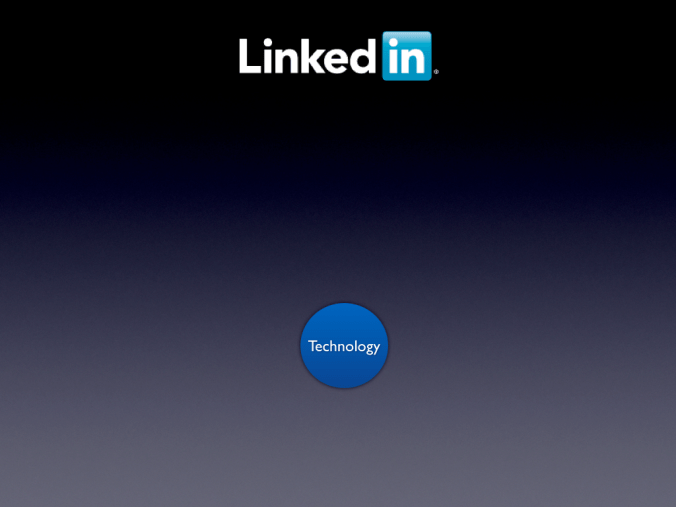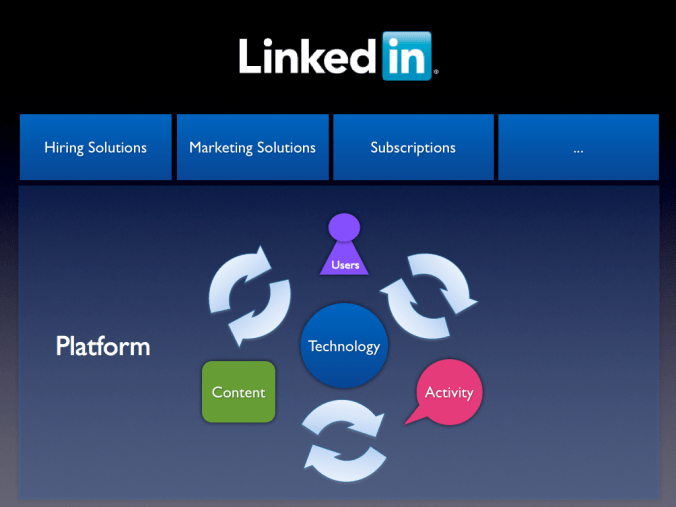From the first conversations that I had with Reid Hoffman about LinkedIn, what was striking was the amazing clarity about how value is created by social web properties. Those conversations turned into one of my favorite talks, where I walk through the basic understanding of LinkedIn as a Platform business for students and new hires.
Since it’s a such a popular framework, I thought I’d capture an outline of it here so that others can benefit from it. There is nothing here that won’t be familiar to industry insiders and folks who focus on social software. However, I’ve found that most people, especially technologists who have not had first hand experience with social platforms, seem to find this useful & interesting.
LinkedIn as a Platform
I started my career as a software engineer, and as a result, I’ve always had a very technical view of what defines a platform. Across multiple decades, platforms tended to be defined by technical constructs: entities and services that are exposed to software developers.
What’s most interesting about the social web is that, for the first time, technology is necessary but insufficient to deliver a successful platform. So while LinkedIn is a technology company and great technology is a prerequisite for a great platform, it’s important to understand that in this generation great technology alone won’t ensure success.
Why the Social Web is Different
The reason why technology alone isn’t sufficient is due to the simple fact that on the social web, the true value of the platform extends from the users themselves.
First and foremost, users interact with each other. At LinkedIn, the very first type of interaction was the simple act of connecting. If you look at Web 1.0 companies, they spend an inordinate amount of money on user acquisition. On social properties, user acquisition is effectively free because users generate activity, and that activity brings in other users. This activity can be an invitation, a message, a comment, a like – any way that one person can reach out and contact another user. More importantly, as a metrics-oriented product manager I can tell you, the likelihood that a person will respond to another person is easily an order of magnitude (10x+) higher than the response rates of a person to a company. (Just think about your inbox and you’ll see it’s obviously true.)
What’s interesting about all of this user activity is that, in fact, activity itself is a form of content. When someone responds in a group, comments on a status update, votes on a poll, or answers a question, they don’t just interact with other users – they also create content. That content, as it turns out, becomes a catalyst for other people to engage and interact.
In fact, one of the primary aspects of a social platform is that users generate content. Once again, looking back at the Web 1.0 generation of websites, content creation was one of the most challenging things to economically scale. On social websites, users generate the bulk of the content. What’s more, that content itself drives additional users to the site. For example, the very first type of content that users created at LinkedIn was their professional profile. Users discover this content via search engines, applications, and social distribution, and they join LinkedIn to engage with that content.
When developers want to connect with the LinkedIn platform, whether they are giant companies like Microsoft and SAP or tiny startups, the technology is just the means. What they really want to connect to is this incredible engine of professionals, content, and activity. It’s this vibrant, circulating, and growing engine of content that developers want to connect to. This entire engine is really the LinkedIn platform.
Businesses Built Over the Platform
LinkedIn has had an open developer platform since late 2009, but it was in very early days that the company realized that it was fundamentally a platform business.
Despite it’s popular reputation as a site that has always made money, for the first few years LinkedIn did not focus on monetization at all. There was always a high degree of confidence that if you could aggregate the world’s professionals and understand their reputations and relationships, it would be a new and incredibly valuable ecosystem. However, around 2005 and into 2006, LinkedIn began experimenting with a few different theories on what the best way to build a sustainable business over this platform.
One theory was that, when you pull together a huge number of professionals, there would be an opportunity for hiring managers and companies to find great talent. This was the precursor to the “Hiring Solutions” family of products.
Another theory was that, when you pull together a huge number of professionals, there would be an opportunity for companies to reach professionals with their products and services. This was the precursor to the “Marketing Solutions” family of products.
Yet another theory was that there would be a small percentage of power users who would be willing to pay money for additional search and communications capabilities. This was the precursor to the “Subscriptions” family of products.
Now, all of this pre-dates my joining the company, but what is truly amazing about this story is that, very quickly, all of these businesses worked. And by worked, I mean they started immediately generating interesting and growing revenue. This is also why LinkedIn slammed to positive cash flow so early in its history, and why the first party I got to attend when I joined the company was the “In the Black” party where the company celebrated that milestone. (It was a good party.)
I can’t tell you how unique it is to have a technology startup that finds not one, but three potentially huge revenue streams early in its history. In fact, most venture capitalists tend to prefer that companies find a single business model to execute against.
But the truth is, this was the catalyst for realizing an important fundamental truth: the LinkedIn platform is an incredibly powerful and valuable ecosystem, and that multiple great businesses can (and will continue) be built over it.
Where LinkedIn Spends Most of Its Time
One of the great things about LinkedIn as a company is that there is incredible alignment across the company about how our ecosystem creates value. The value comes from the vibrancy of the professional network itself.
This is why, across the company, you’ll see that the vast majority of energy is spent on figuring out how to leverage this platform of professional identity and insights to make LinkedIn more useful, more often to professionals globally. It turns out that the more professionals, the more activity, the more content created, the more value is created for all of LinkedIn’s businesses.
This is why LinkedIn puts their members first. Our job is to connect the world’s professionals, and make them more productive and successful. The rest follows.
Extending LinkedIn Across the Web
As LinkedIn extends itself as a true professional operating system for the web, the incredible volume and velocity of professional identity and insights will provide value to a whole new generate of web, desktop, mobile and enterprise applications.








Adam, great post—I love to see how a simple breakdown of the platform, from the perspective of the creators, and how it tested the logical revenue streams (and amazingly, succeeded with all of them!).
I also find it interesting that there’s little mention here of the 3rd party ecosystem and the developer/API influence over the platform. Could you expand slightly on how that fits into this picture?
Pingback: Joining Greylock « Psychohistory